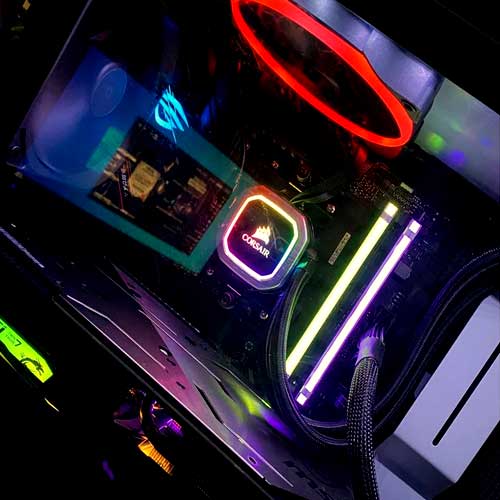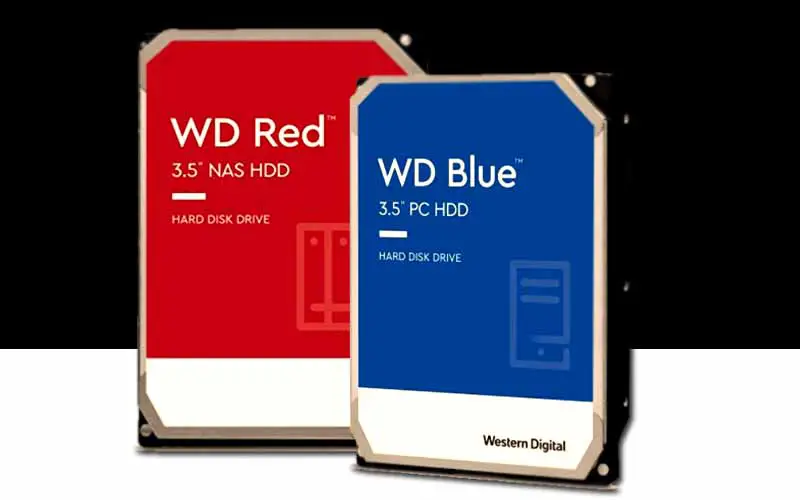WD Red and Blue come among the series of colored hard drives by Western Digital. Each drive is made especially for a particular software. For instance, a red drive is made for an environment in which a blue drive can’t function well.

Choosing the right drive is very important and so for this purpose, you should have a clear understanding of the colors by WD, to make a suitable drive purchase to run your apparatus.
Both drives are meant to offer a lot to their users. Unluckily, the red drive doesn’t offer a handsome amount of capacity options to choose from. Whereas the blue one has more wide range of storage options and any user can get the least storage of 320 GB to use in a common PC where the Red drive can’t be used.
It appears that the Red drive limits its buyers and only those users can buy it who are looking for a NAS drive or a drive with storage up to 2 TB. But a user looking for a drive under 1TB or less, can’t access the Red drive.
But there are a few points that stand in favor of the red drive as well. Even though WD red is not suitable for gaming but it’s worth mentioning for SOHO(small office/home office) environments, RAIDS, home-based cloud storage, and server investments. But there’s a major thing besides it.
Although the Red drive is a successor of the blue one WD blue wins at most of the points like price ranging, rpm, form factors, and capacity.
Whereas the red drive has not had much to bring to the table.
Also, there are more suitable NAS HDD alternates in the market for the WD red drive that is better in performance and other factors. So, the blue HDD gets more authentic points here.
Table of Contents
WD Red vs WD Blue – Understanding of the colors
WD Red:
The Red drive is a successor to the Black drive and is designed for NAS environments from 1 to 8 bays.
The basic purpose for the Red drive isn’t for gaming, or use as a standard drive in PC, but is to offer a wide range of storage to build a NAS solution.
WD Blue:
WD Blue is the most common drive that is found in almost all systems as it is a kind of PC hard drive, unlike the Red one that is designed for NAS.
It is used as a sort of primary drive in notebooks and external enclosures.
Both drives differentiate from each other in several ways. Or we can say, both drives are opposite from one another as both of them are manufactured to process different systems. Here’s how:
NAS environment:
Network-attached storage (NAS) works at a professional level. The server is meant to provide access to the data to the employees or heterogeneous groups.
So, a specific drive that is made for a NAS environment should be used in it to avoid any problems. As mentioned earlier, WD red is a NAS hard drive and it can function well than the blue HHD in a NAS system. Now the question arises here;
Can we use a WD Blue drive in NAS?
It’s not like using the WD drive will not work in a NAS environment. But the thing is, blue drives are made for desktop use and not for use in NAS.
The consequences of using WD blue in NAS can be:
- Slowing down the transfer procedure speed if WD blue is used along with WD red and especially if using RAID.
- WD Blue might die out earlier than the red one.1
To avoid any problems afterward, it’s good to use a NAS-made drive in a NAS environment.
Purpose of WD Red and WD Blue:
In many NAS, you’ll have multiple drives that will operate in a RAID environment. If multiple standard drives like WD Blue are used here and there comes a problem in a drive, the windows will wait and slow down as with multiple drives the RAID controller is unable to read that much so it is assumed that the drive has failed and your RAID will get degraded.
This happens because a standard drive like blue is designed for desktop-like windows and windows uses only one drive to operate.
So, there is not much problem there as only one drive used in a PC can recover even by slowing down the system a bit. But the complexities increase when multiple drives are used at a time (in NAS).
For this reason, the Red drive is purposed for NAS to prevent all these problems.
And a Blue drive being a primary drive is purposed for a PC where only one standard drive can operate the system well.
Capacity:
WD Red comes with storage of 1TB to 6TB. The other models of the same series like WD Red Plus and WD Red Pro come with storage of up to 48TB.
In their standard blue drive, Western Digital presents from 320 GB to 6TB of storage which is more than enough for everyday use.
Cache Memory:
In comparison to the cache memory of both the drives, the red one stands here with 256 MB of cache memory which is far better than the cache memory of 64 MB in the other drive.
This is because 256 MB provides enough room to temporarily store a huge amount of data to be utilized by the computer afterward. Hence, giving a boost to the fastest performance speed of the drive.
Form Factors:
WD Red comes with only one form factor of 3.5. While the other drive offers two form factors of 2.5 and 3.5. The 2.5 form factor is available in up to 1TB blue drive.
But for the drives with a capacity of more than 2TB, you’ll get a 3.5 form factor.
The 2.5 size makes the drive a perfect fit for a computer as well as a laptop because a laptop can stand a drive with a 2.5 form factor and that’s what the blue drive has to offer here.
So, the blue drive has more choices to offer as compared to the red one.4
Performance:
One of the most important things in the performance of a drive is the transfer rate. When an experiment was performed on the 6 TB model of both the drives, the Red drive came up with a transfer rate of 180 MB/s while the blue one resulted in up to 175 MB/s.
In the case of RPM(revolutions per minute), both drives differentiate from one another. RPM indicates the speed of a drive. More the RPM a drive has, the higher its speed rate will be.
This means that the Blue drive with 500GB and 1TB of storage has 7200 RPM which is greater than the 5400 RPM of red drives and the blue drives with above 1TB of storage.
It means that the drives with 7200 rpm deliver the data 33% faster than the 5400 rpm. So, the blue one will have more read/ write speed than the red one 5.
Which drive has the better MTBF?
MTBF(mean time before failure) has a direct connection with the reliability of the drive. For instance, if you get to know the causes of failure by measuring the MTBF of the drive at a right time, you can take steps in resolving the cause.
That can improve the reliability of the drive and it may stay for a longer life span. So, a drive should offer a good MTBF for reliability purposes.
The red drive has an MTBF of about 1 million hours while the other drive has a longer life span of about 1.75 million MTBF hours.
Price Ranges:
The price for a drive varies according to the capacity of the drive. The Red drive comes with about 3 years of warranty and is way more expensive than the blue ones that have 2 years of warranty by WD.
The reason is that Red drives are made to support heavy environments(i.e NAS) which isn’t easy for a blue drive.
Many other drives by several companies are also designed for NAS systems and have relatively less price with more warranty than the Red one by WD.
Such as the HGST drive has more rpm of 7200 than the 5400 rpm of the red drives. The product comes with 5 years of warranty as well which is 2 tears more than the red drive.
Compatibility with heat:
Heating up of the drive is very common as it is the everyday case. As far as it’s a minor heat up there’s nothing to be afraid of.
But if the drive heats up above a moderate temperature, the consequences can be severe including drive failure.
So that’s the very point that matters at the time of purchasing a drive.
As red drives are designed for 24/7 purposes, so there are no such heat issues until you are getting a heavy file transfer or any other external harm to the drive. While the blue one isn’t designed for 24/7 use, if the drive is used this much, you might face heat-up issues.
